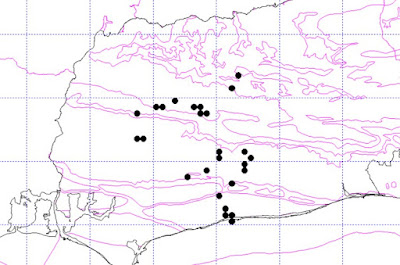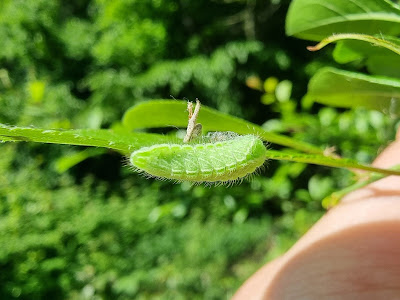It's took quite some effort to race through the remaining specimens and get the data into a useful format, though here we are. First off, all the photos in the post (unless I state otherwise) are Dave's that he took with his phone (like this stonking Stenocorus meridianus on Wood Spurge at Hoyle). They are far better (and more numerous) than the few I took on the day.
Before I start, a massive thanks to everyone who donated. We raised an incredible £2680! You can still donate here.
First off, the overall total for the challenge was 1072 species found, recorded and identified on the day. Just 37 species more than we managed in 2017. However, with the specimens I took, that figure rose to 1158 species. Pretty pleased with that. The total number of invertebrates found and identified on the day was 555 species, rising to 622 with all the identifications added. Here's how are totals compared to 2017 and what they looked like after the identifications made post 25th May were added. I was surprised we had such lower plant totals but we really did well on spiders and beetles.
Our route went: Burton Pond, Graffham Common, Hoyle Farm, Levin Down, Rewell Wood, Climping Dunes, Peppering Farm and then back to Dave's. Singleton and Charlton were also pretty good!
Burton Pond
I'll put the full species list at the end but for now, some highlights. First up, Burton Pond. We spend the first seven hours at this very diverse site on the Greensand Ridge. I was pleased to find that we recorded 73 species of invertebrate there that had not been recorded there before, including five species never recorded on a Trust reserve before. Such as this Nationally Scarce sapro, Prionychus melanarius I found under bark in the Warren.

We set the moth traps up and turned them on at exactly midnight, with one minute to spare! We then got onto beating, sweeping and suctioning before the dew started. I am not good on very little sleep and spent the first two hours trying to overcome an intense sense of impending doom. Then the Moon came up and it started to get pretty cold - but it was really weird being out so long that we watched the Moon go back down again. We did get a few good moths though, including 15 species new to the site. Surprising for such a small moth list and a well-recorded site!
Bird's Wing was indeed new to the site and Dave got excited by it!
A Privet Hawk-moth scared the bejesus out of us!
While we got a few larvae as well, including a couple I have not come across before. This is Dingy Footman.
And this two-tone fluffkin is actually a Rosy Footman!

Nightjars were all over Burton, which really surprised me. Over the day we got to 77 bird species, which I think is pretty good as we did not chase a single bird. We didn't however see a Kestrel, Little Egret or Bullfinch (the Great White Egret we had over Welch's Common on the reccy was a big ask to see on the day). I think I got about 10 lifers (which has helped get my personal pan-species list to 9000 species, wahoo!), mostly through the specimens but this gelechid was common at light there. It's Carpatolechia proximella.
We left Burton after a glorious sunrise to head to Graffham Common. Great photo, Dave!
Graffham Common
For some reason, we didn't take any photos at all at Graffham. It was oddly quiet there. Uloborus walckenaerius was in the first sweep net and we soon heard Hobby, Siskin, Crossbill and Garden Warbler. We still got 12 species new to the site, including (and this really surprises me) Lesser Cockroach - which was new to the Trust reserve network. I am sure it must have been reported from Rye Harbour?
Hoyle Farm
We got to Hoyle shortly after 9.00 am. I first surveyed this site last year and my third visit of the survey produced the most field dets I have ever had (297 inverts in just six hours of recording back in August last year). So we had to visit it. It did not disappoint. After a slow start at Graffham Common, it soon felt like we might make the 1500 species after 2.5 hours at Hoyle. Despite recording 621 species over three days last year, we still recorded 50 species on Saturday that I did not pick up last year. A highlight for me was this Pilemostoma fastusoa (Nationally Rare and Near Threatened) this species is not that uncommon on Common Fleabane in the West Weald. In fact, we had five species of tortoise beetle in an hour. So have a Nationally Scarce Cassida prasina too! These are my only photos here, my lens looks scratched compared to how bright Dave's phone shots are.
I was explaining to Dave my rule that if I see something, I have to sample it. I saw a big stand of Blackthorn and tapped it. Out popped a Brown Hairstreak! It's not every day you see this Vulnerable, Section 41 butterfly and it made up for the lack of any Purple Hairstreak larva.
We got into the woods there which were also really great, including large charismatic species such as the longhorn at the top and this Chrysomela populi on Aspen.
A massive thanks to Bianca for hosting us and a providing coffee and nuts! I'm glad we were able to find so many new species for the site, including some really key invertebrates.
Levin Down (via Singleton and Charlton)
It got very hot between 1 and 2 pm and I started feeling a bit unwell in the sun. But I ploughed on. Obviously we added a lot of new plants but the inverts were not coming through as thick and fast as we would have liked.
We did get a few nice spiders though. Including the Nationally Rare/Vulnerable Trichoncus saxicola, at its only Sussex site. Entelecara flavipes (another Nationally Scarce money spider) was new to the whole reserve network. Butterflies were good, with Grizzled Skipper, Dingy Skipper and Small Blue added here (we had 15 butterflies on the day!). This ball of Common Blues in mating frenzy was something!
A few nice bees too but they were not new to the site, Stelis ornatula, Andrena florea, Ceratina cyanea and Osmia bicolor were all nice and easy to ID species (although I didn't spot the Ceratina in the field). However, the super rare stonefly Nemoura lacustris that I found in the specimens was a lifer and another species new to the reserve network. On the NBN, there is a cluster of records around Charlton would you believe it. I guess it must be a chalk stream thing! What a result. I am so pleased we added 24 species to the Levin site list. In fact, between the three Trust sites we surveyed, 109 were new site records and a whopping NINE species had never been recorded on any Trust reserves.
This site really didn't pay off for some reason (two many species already picked up on similar soils maybe) and it went from being swelteringly hot to cool in the blink of an eye. A Pearl-bordered Fritillary was a target but the Cream-spot Tiger netted in flight was a highlight. It was at Rewell that it dawned on us that we were not going to make the 1500 species.
Climping Dunes It was quite cold by the time we got to Climping, so many of the species I found on the reccy could not be refound. The plants were great though. And Sand Catchfly was a highlight for the whole day. There were a few nice inverts like Grey Bush-cricket, Dune Robberfly and Acrosathe annulata.
And the days only fish...a Small-potted Catshark.
And then back to Dave's for more moth-trapping and microscope work. It wasn't long before this Pygmy Shrew paid us a visit!
Although the first moth trapping at Burton was quiet, the trap was quite lively with an Alder Kitten a rare encounter for me. The last species of the day was this Great Silver Water Beetle. I was sat at the microscope for 2.5 hours but probably only added about 40 species. It was much harder doing this tired in someone else's house than I expected. In fact, it took about 15 hours to process all the specimens, and they only added about 150 species. So, for the 24 hour challenge, I actually think you are better not taking specimens. From a records point of view though, many of the best records came out of this lot.
So that's it! Here's us at about 7.00 am. We did not look like that by the second midnight! So before I finish with the entire species list, it's so long until the next time we are crazy enough to try something like this again.
Oh, one last thing. Out of the 622 inverts we recorded on the day, a whopping 58 had some form of conservation status (such species are included in bold in the following list). Many of these are now out of date but I have not had time to differentiate these. Also, this list is the full 1158 species and includes the 86 microscope IDs added after the challenge, I'll try and update it if I get time but a period of high pressure means I will be head down with work for days/weeks now.

































Post a Comment